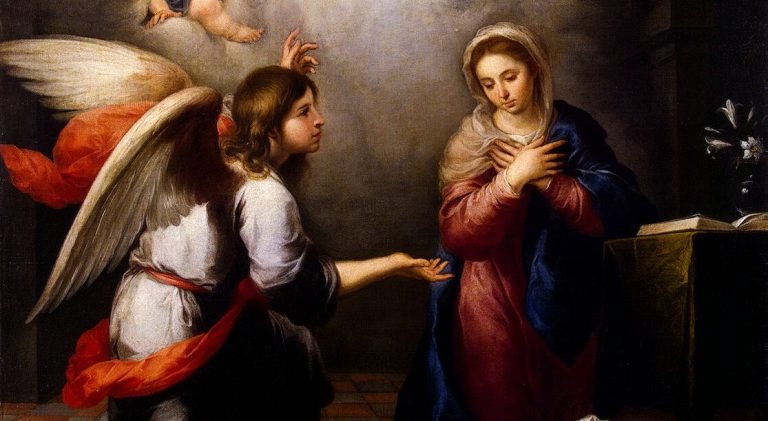By Mauro Gagliardi [social-share]
Mauro Gagliardi, S.T.D, a priest of the Archdiocese of Salerno (Italy), is a Professor at the Pontifical Athenaeum Regina Apostolorum and Visiting Professor at the Angelicum. Fr. Gagliardi has also taught as a Visiting Professor in Spain and the United States. Pope Benedict XVI appointed him as Consultor to the Office for the Liturgical Celebrations of the Supreme Pontiff and Consultor to the Congregation for Divine Worship and the Discipline of the Sacraments. Fr. Gagliardi has authored ten books and is the editor or co-author of another seven, including Truth Is a Synthesis.

Within the invisible creation, there exists a hierarchy of heavenly spirits. In the Bible we find various orders of the choirs of angels: Cherubim, Seraphim, Thrones, Dominions, Principalities, Powers, Virtues, Archangels, and Angels. The principal author referenced for this theme is Pseudo-Dionysius the Areopagite (AD fifth or sixth century), who composed a work entitled De Coelesti Hierarchia (The Celestial Hierarchy), to which many subsequent authors refer. He distinguishes three angelic orders:
1) Seraphim, Cherubim, and Thrones assist at the throne of God.
2) Dominions, Virtues, and Powers are occupied with the governance of the cosmos.
3) Principalities, Archangels, and Angels carry out various divine assignments such as delivering announcements, combating Satan and his angels, and acting as guardian angels.
However, if we consider the heavenly spirits that are angels, we see that it is true that they are “in Heaven”; Revelation nonetheless shows their frequent presence and action on earth.
The word angel literally means “messenger.” The angels are creatures that continuously deliver announcements and gifts of God to human beings and creation. Being creatures, their ontological difference with respect to the Creator is infinite. Thus, while being heavenly spirits, they are much closer to us than they are to God. This derives from the unity of creation in its two aspects, visible and invisible.
The doctrine of the Church also recognizes the role of the “guardian angel”: every human being is granted the personal and continuous care of a heavenly spirit. Finding a basis in certain biblical passages, various Fathers and theologians have held that there are guardian angels of the various Churches (or dioceses), nations, regions, and cities. A large number of saints have had mystical experiences of the angels or their own guardian angels, even in certain cases reaching a very deep relationship with them, formed from many conversations.
It is well-known that, according to Catholic doctrine (based on certain biblical passages: see John 8:44; 2 Pet 2:4; Jude 6), a certain number of angels, namely, Satan and the other rebellious angels—created good by God in the beginning—suffered definitive estrangement from God due to a sin of rebellion. These angels are not found in Heaven with God, nor will they ever be found there. The Catholic doctrine teaches that there is no longer any possibility of redemption for them, because they are definitively fallen from grace and salvation. The “transformation” of a certain number of heavenly spirits into demons is described with the image of a fall, on the basis of the words of Christ: “I have observed Satan fall like lightning from the sky” (Luke 10:18). It is then described in Rev 12:7–9:
Then war broke out in heaven; Michael and his angels battled against the dragon. The dragon and its angels fought back, but they did not prevail and there was no longer any place for them in heaven. The huge dragon, the ancient serpent, who is called the Devil and Satan, who deceived the whole world, was thrown down to earth, and its angels were thrown down with it.
When Saint Paul speaks of a reconciliation between heavenly and terrestrial realities, he is not referring to the rebellious angels, who cannot be reconciled to God. He is referring instead to the heavenly spirits that remained faithful to God, and from whom the human being is also separated on account of sin. Thus, sin is not just a dramatic break between God and humanity, between creature and Creator; it also entails a split within the created world: between rational terrestrial beings (humans) and heavenly ones (angels). Moreover, the sin of the human being carries with it a wound of the entire material cosmos, which affects all non-rational corporeal creatures. This is attested by Saint Paul in the Letter to the Romans:
For creation awaits with eager expectation the revelation of the children of God; for creation was made subject to futility, not of its own accord but because of the one who subjected it, in hope that creation itself would be set free from slavery to corruption and share in the glorious freedom of the children of God. We know that all creation is groaning in labor pains even until now. (Rom 8:19–22)













